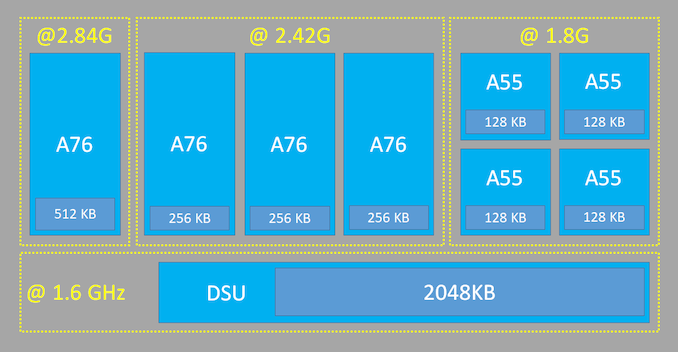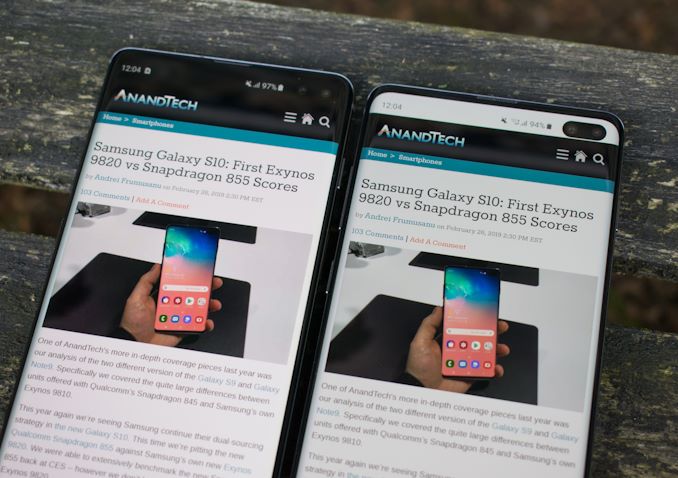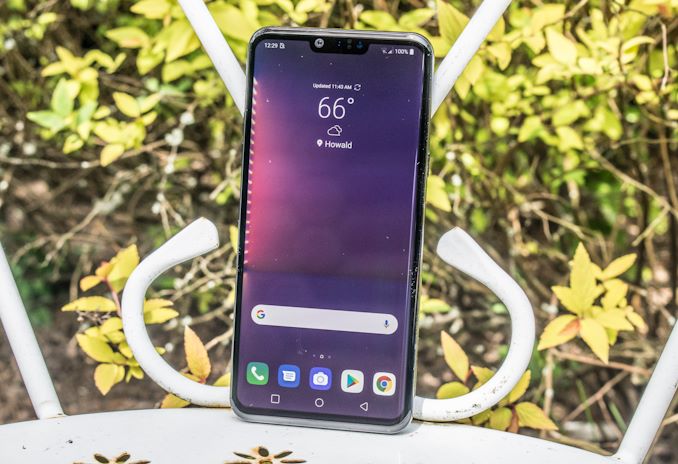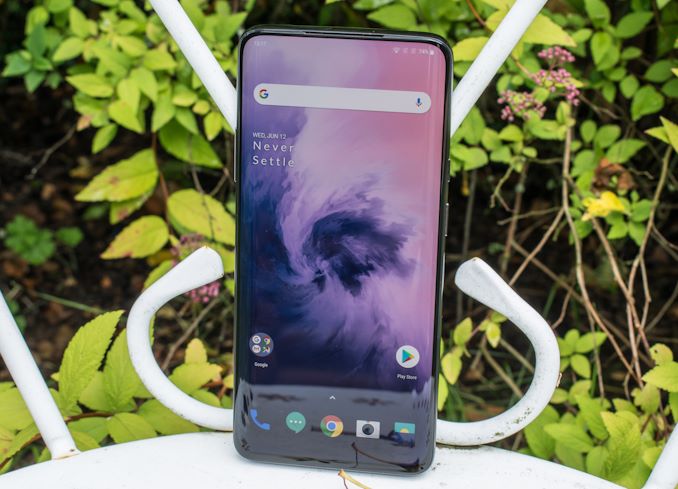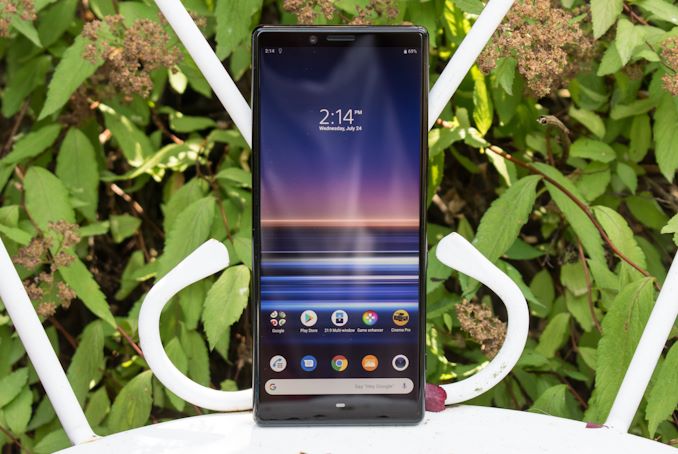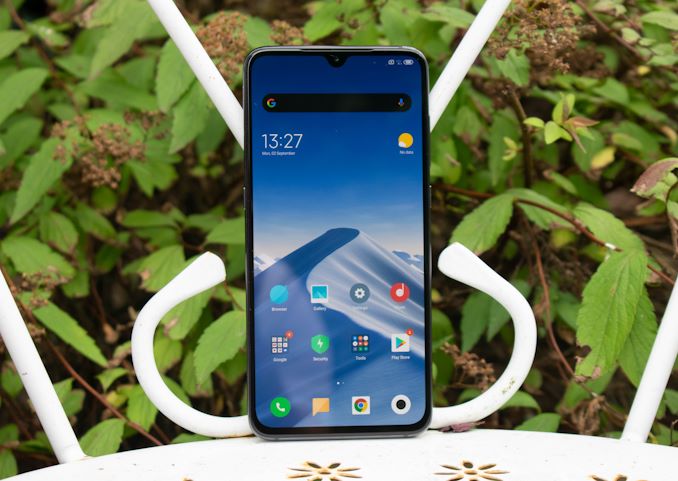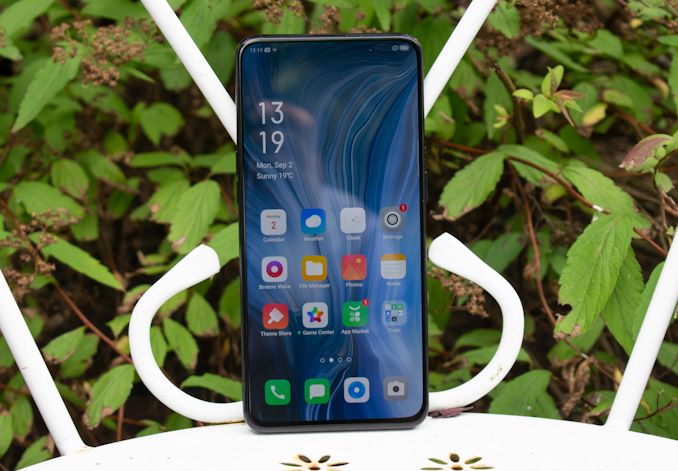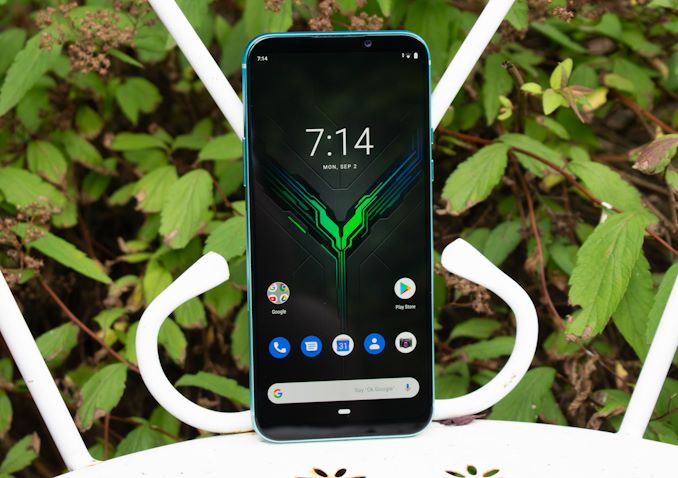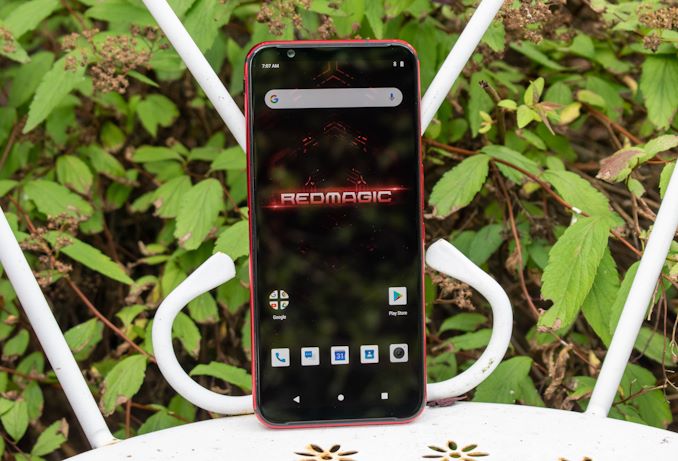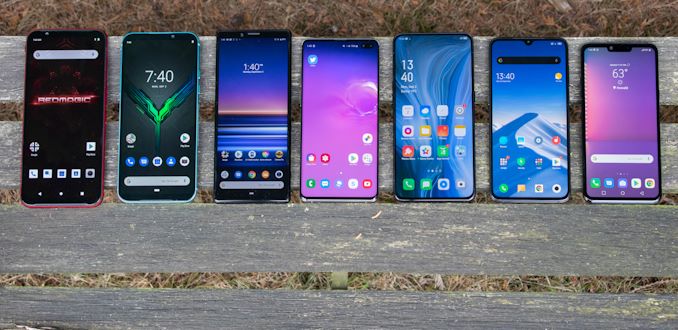
Original Link: https://www.anandtech.com/show/14794/snapdragon-855-phone-roundup-searching-for-the-best-implementations
The Snapdragon 855 Phone Roundup: Searching for the Best Implementations
by Andrei Frumusanu on September 5, 2019 8:30 AM EST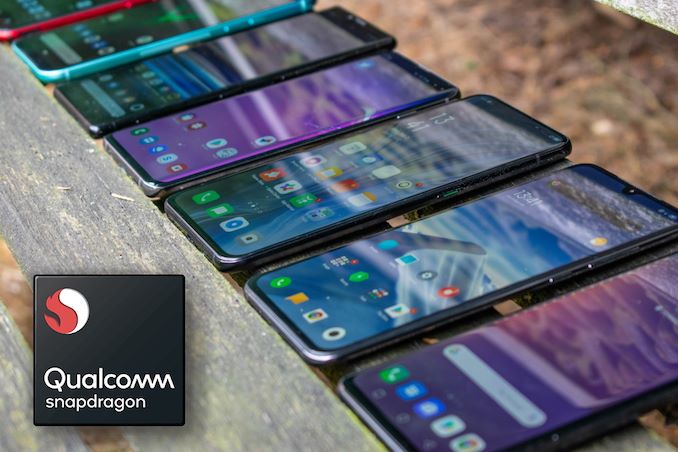
Over the last few years we’ve seen a lot of changes in the mobile market when it comes to the internal hardware of devices. At the heart of every smartphones sits the SoC, which dictates almost every aspect of a device’s experience. Qualcomm has played a major role in shaping the smartphone, thanks to its widely-used Snapdragon platform. The company has had its ups and downs over the last few years, but particularly starting with the Snapdragon 835 from a couple of generations ago we’ve seen some continued and very robust execution from the chip vendor.
This year, Qualcomm’s flagship SoC was the Snapdragon 855. The chip is well known and has been powering the vast majority of Android devices this year, bar a few exceptions. With so many options from various vendors, an interesting question arises: who has managed to do the best implementations in getting out the most out of the silicon? To help settle that question, today we’re doing a smartphone roundup – we're taking a look at device performance from a slew of different S855 devices from various vendors, while investigating how software and hardware designs can change a device’s experience on the very same silicon.
| Qualcomm Snapdragon Flagship SoCs 2018-2019 | |||
| SoC |
Snapdragon 855 |
Snapdragon 845 | |
| CPU | 1x Kryo 485 Prime (A76 derivative) @ 2.84GHz 1x512KB pL2 3x Kryo 485 Gold (A76 derivative) @ 2.42GHz 3x256KB pL2 4x Kryo 485 Silver (A55 derivative) @ 1.80GHz 4x128KB pL2 2MB sL3 @ 1612MHz |
4x Kryo 385 Gold (A75 derivative) @ 2.8GHz 4x256KB pL2 4x Kryo 385 Silver (A55 derivative) @ 1.80GHz 4x128KB pL2 2MB sL3 @ 1478MHz |
|
| GPU | Adreno 640 @ 585MHz | Adreno 630 @ 710MHz | |
| Memory Controller |
4x 16-bit CH @ 2092MHz LPDDR4X 33.4GB/s 3MB system level cache |
4x 16-bit CH @ 1866MHz LPDDR4X 29.9GB/s 3MB system level cache |
|
| ISP/Camera | Dual 14-bit Spectra 380 ISP 1x 48MP or 2x 22MP |
Dual 14-bit Spectra 280 ISP 1x 32MP or 2x 16MP |
|
| Encode/ Decode |
2160p60 10-bit H.265 HDR10, HDR10+, HLG 720p480 |
2160p60 10-bit H.265 720p480 |
|
| Integrated Modem | Snapdragon X24 LTE (Category 20) DL = 2000Mbps 7x20MHz CA, 256-QAM, 4x4 UL = 316Mbps 3x20MHz CA, 256-QAM |
Snapdragon X20 LTE (Category 18/13) DL = 1200Mbps 5x20MHz CA, 256-QAM, 4x4 UL = 150Mbps 2x20MHz CA, 64-QAM |
|
| Mfc. Process | TSMC 7nm (N7) |
Samsung 10nm LPP |
|
The Snapdragon 855 is Qualcomm’s first chipset to come manufactured on TSMC’s 7nm process node, giving the chipset a much-heightened degree of power efficiency, which in turn enables it to have achieve a high degree of performance.
The chip is powered by a derivative of Arm’s Cortex-A76 and Cortex-A55 cores. Qualcomm markets these as the Kryo 485 cores. The company makes use of Arm’s “Built on Cortex Technology” license which allows vendors to request changes to some of the microarchitectural configurations of the “standard” IP core. In the case of the Kryo 485, Qualcomm has revealed that it has raised the re-order buffer of the core from 128 to a higher undisclosed figure. It’s to be noted that the successor of the Cortex-A76, the A77, comes with a 160 entry ROB, and given that the RTL is still designed by Arm, I’d wager Qualcomm was an early beneficiary of this work. Other improvements are found in the prefetchers which are said to be tuned for more web-browsing type of workloads.
The key aspect of the Snapdragon 855’s CPU complex is the fact that it’s a 1+3+4 setup. The single large “Prime” performance core runs at up to a 2.84GHz clockspeed and uses a larger 512KB L2 cache, whereas the “Gold” or middle cores run at up to 2.42GHz and have 256KB L2 cache implemented. The bigger cores are paired with four A55 derived cores running at up to 1.8GHz and serve as the efficient workhorses of the chip. The whole complex is tied off with a 2MB L3 cache running at up to 1.6GHz.
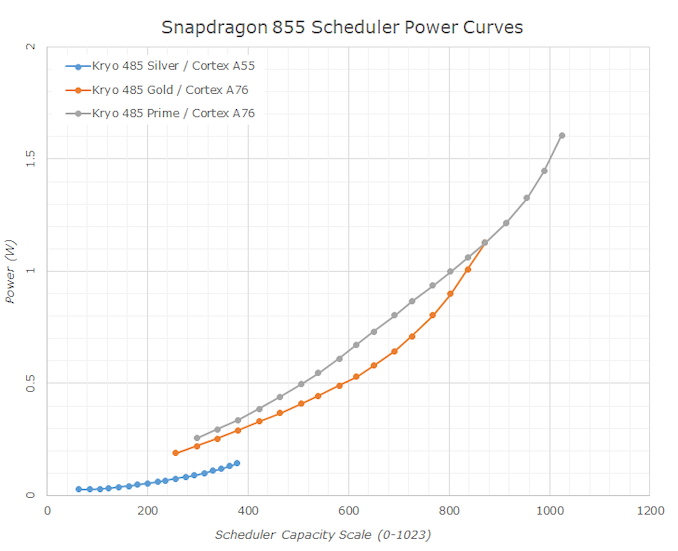
The reason for the 1+3 configuration is that Qualcomm achieves better a better silicon area footprint while also min-maxing any given workload's power efficiency and maximum single-threaded performance. The Prime core is implemented via more relaxed transistor library which enables it to reach higher frequencies at a cost of higher leakage. The middle cores are implemented with a more tight and power efficient library, using less power clock-for-clock than the Prime core, but hitting the frequency wall earlier in its frequency/power curve.
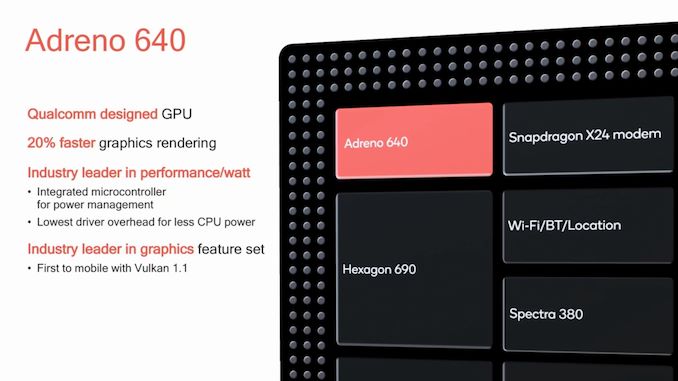
Meanwhile the Adreno 640 GPU is a new iteration over last year’s Adreno 630. The GPU seems largely the same, as it's part of the same architecture family. However, Qualcomm notably changed the execution unit count in the new block, and as a result the Adreno 640 has 50% more ALUs than its predecessor. Interestingly, despite this large increase in execution units, Qualcomm only promised a more modest 20% increase in graphics performance. This difference is due to the new GPU going for a slower-and-wider philosophy, with Qualcomm running it at lower clock compared to its predecessor, reaching only 585MHz versus the 710MHz of last year's Snapdragon 845.
Other big changes in the Snapdragon 855 include Qualcomm’s introduction of a new Tensor processing unit integrated with its Hexagon DSP – a block which also saw a doubling of its execution prowess. It’s to be noted that the Tensor accelerator to date seems to have seen little action, as Qualcomm says the IP will only see more usage on newer Android 10-based device drivers, which will finally enable the block to be exposed to the OS's Neural Networks API (NNAPI) acceleration.
But it’s the same chip! How will performance differ?
Today we’ll be looking at 8 different Snapdragon 855 devices from various vendors, including a few different devices from the same vendor. One would be actually surprised to expect much variation from a group of devices being powered by the same SoC; however as we’ve learned over the years, aspects such as software and the physical hardware design of a handset can have great impact on the performance of a device – particularly in thermally constrained workload scenarios such as gaming.
Putting 8 different devices with the same SoC against each other gives us a unique perspective on the topic of software optimizations, as well as device thermal dissipation design, all of which will hopefully shed some light on which vendors were able to deliver the best implementations of the Snapdragon 855 platform.
Top Devices - The Well Knowns
First of all we’ll be going over a brief overview of the various devices, covering their unique aspects and what makes them stand out from the competition.
Samsung Galaxy S10+
Starting off with the Galaxy S10+, the device should really need no introduction. Samsung was among the first vendors to actually employ the Snapdragon 855 this year, and to date has been able to be one of the, if not the most, successful Android devices of the year. The Galaxy S10 is characterized by its new design language with a edge-to-edge screen which includes the much discussed camera cut-out. Further features which mark the Galaxy S10 is the triple-camera setup which includes normal wide-angle, telephoto and ultra-wide-angle lenses which were the top camera performers of this year – at least till time of writing.
Samsung also manage to be exceptionally power efficient this year. The inclusion of a 4100mAh battery was a boon, however Samsung’s very power efficient screen employed in the phone was able to put it ahead of other Android devices when it comes to battery longevity.
The company continues to use a dual-sourcing strategy, using both Qualcomm’s as well as Samsung LSI’s own Exynos chipsets in the same phone. We don’t really know why Samsung does this, as sometimes it can very much dilute R&D efforts to create the same phone with two hardware platforms. The benefit here is that we’re able to have an apples-to-apples comparison device and directly comparing Qualcomm’s Snapdragon SoCs against Samsung’s Exynos chip. This year, the Qualcomm variant yet again managed to be the superior device, delivering an almost flawless experience while the Exynos variant had some rough edges here and there in terms of performance or camera experience.
Read Our Galaxy S10+ Full Review Here
LG G8 ThinQ
LG had also been among the earlier adopters of the Snapdragon 855 in the new LG G8. This year LG was able to greatly improve on the hardware experience compared to the G7 last year. The G8 is also the first in LG’s G-series to come with an OLED screen whereas all previous generations were still using LCDs. LG still has issues with its own OLED panel production as we’ve seen rather lackluster panel power efficiency compared to Samsung or even BOE, of which the G8 also suffers from, ending up with average battery life.
The G8’s camera this year was much improved, and in particular daylight quality was a strength of the phone. LG oddly opted to deliver the G8 with only two camera modules in western markets, the main camera sensor and the wide-angle, reserving the triple-camera variant with the added telephoto module to Korean domestic markets.
Other specialties of the G8 include a new under-screen piezoelectric speaker under the top screen, replacing the traditional earpiece speaker. To date this has been the best implementation of its kind in terms of audio quality, with the new unit being used a stereo speaker. One attempt to differentiate the G8 from other devices was the introduction of a time-of-flight sensor which enabled Minority Report-like gestures to control the phone. Unfortunately I found these to be rather gimmick and offer very little added experience in daily usage of the phone.
Read Our LG G8 Full Review Here
OnePlus 7 Pro
Another popular Snapdragon 855 device this year was the OnePlus 7 Pro. This year marked the first time that OnePlus delivered two device tiers at the same time, putting the 7 Pro a tier higher than the regular new OnePlus 7. The company’s rationale here is that as it matured it’s able to offer more refined experiences and hardware, which in turn come at a higher price point.
The 7 Pro’s key characteristic is its screen, in particular two unique aspects of it. First of all, it’s a bezel-less design without any kind of notch or cut-out, offering a true full-screen experience which gives the phone a very modern look that stands out compared to other 2019 devices. The front-camera is implemented via a mechanical slide-out mechanism at the top of the phone, which is one way of delivering on the bezel-less screen experience.
The other key aspect of the phone is the fact that it’s using a 1440p 90Hz OLED screen – which to date is still unique. The 90Hz experience is in particular something that makes the phone stand out and the single most important key feature of the phone that would want one to use the OnePlus 7 Pro.
Weaknesses of the 7 Pro include the fact that it’s quite the big and hefty device, likely thanks to the internal front-camera sliding mechanism. While OnePlus implemented the 90Hz display in the best way possible, it still comes at a cost to battery life, so even though the phone has a 4000mAh battery, its battery life is relatively in the middle of the pack. Further disappointments were found in the camera department which I blame on lackluster post-processing as well as weakness of the camera sensor.
Read Our OnePlus 7 Pro Full Review Here
Sony Xperia 1
The Sony Xperia 1 was the first Sony device we’ve been able to review here at AnandTech. The phone marks a new start for Sony’s mobile division following an internal reorganization and a few years of lackluster sales.
In terms of design language, the new Xperia 1 is certainly a unique device thanks to its 21:9 screen aspect ratio which I’ve found to offer a great experience. The screen is also the phone’s weakness, as Sony’s decision to go for a 4K panel resolution makes very little sense in practice. Yes, it’s the sharpest screen in the market and the uniformity is quite incredible, however the difference to a 1440p screen is just not noticeable enough. Keep in mind this is coming from somebody who deems 1080p screens in smartphones as being insufficient as I can easily see the pixel matrix. The big negative for the phone is found in its battery life, as the meager battery capacity combined with a power hungry screen makes for some quite disappointing results.
Cameras on the Xperia 1 were also a double-edged sword. On one hand Sony managed to get one of the sharpest and most detailed shots in the market, but at the same time the phone suffered from a bad handling of dynamic range and HDR processing, as well as lacklustre low-light performance.
Read Our Sony Xperia 1 Full Review Here
Top Devices - China & Gaming Contenders
Aside from the well-known phones in western markets, we’ve seen Chinese vendors have quite large success in European and other global markets. These devices are less prevalent in the US, however they can offer some unique value and differentiating experiences compares to the usual brands.
Xiaomi Mi9
Xiaomi Mi9 family of phones were among the first Snapdragon 855 devices to be released, hitting the streets at the same time as Samsung’s S10 series. Xiaomi in particular seems to be a leading vendor cooperating very closely with Qualcomm in defining the experience of their devices.
What stands out for the Mi9 is that when it was released, it came at an incredible price-point of only 449€, vastly undercutting other offerings with the high-end Snapdragon 855. Today the Mi9 can be had for as little as 376€, which remains one of our top picks at this price point.
The Mi9 is on the smaller side when it comes to form-factors, and it’s the smallest device amongst today’s roundup, even though by any means it can still be considered a big phone by traditional standards. The build quality of the phone stands out – it’s a very solid yet lightweight device that punches far above its weight and price. Xiaomi still employs a triple-camera setup which puts it on par with other flagship devices this year. The camera quality also manages to easily compete with that of other devices such as the OnePlus 7 Pro – not a big surprise as it’s among the many devices this year using the popular IMX586 camera sensor. In fact, all devices on this page use the same sensor.
Compromises for the Mi9 fall in aspects such as only having a mono-speaker and its battery life being only about average – two well worth compromises for an otherwise incredibly attractive price-to-performance package.
Full review to follow in the next weeks.
OPPO Reno 10x Zoom
OPPO’s main focused for the last several years has been the Chinese market where they’re incredibly successful in, being one of the top smartphone vendors there. Recently, OPPO has decided to enter western market and this year has launched its flagship device sin various markets in Europe. The OPPO Reno series is marked as also having distinguished designs with bezel-less full-screen experiences. The display panel remains an OLED, but unlike the OP7Pro, this remains a 1080p 60Hz unit. We find a similar slide-out front-camera mechanism, just this time around it’s a wedge design instead of the rectangular slide-out on the OP7Pro.
Key characteristics of the OPPO Reno 10x zoom is basically spoiled by the device’s name: It has an augmented telephoto module capable of up to 10x hybrid zoom (6x optical) thanks to the sensor being laid out in a 90° angle and looking out the back of the phone thanks to a mirror prism. It’s the same kind of mechanism that Huawei used on the P30 Pro, but has the same issues of not being that particularly useful in everyday photography. The phone also employs wide-angle and ultra-wide-angle modules, and seemingly is actually able to provide a better image capture experience than say the OP7Pro, even though having the same or very similar sensors all whilst having the same SoC chipset for processing.
Full review to follow in the next weeks.
Xiaomi Black Shark 2
In the last year or two we’ve seen increased popularity in so called “gaming phones”. The design of these smartphones is straight out of the book of laptop manufacturers who offer specialized “gaming laptops” that are characterized by their unmistaken “gaming design accents” – for a lack of a better description.
Xiaomi last year with the original Black Shark was among the first to offer such phones, and this year we saw the follow-up with the Black Shark 2. The phone’s key differentiators here is that it’s offering a more “robust” design as well as a hardware switch that puts the phone in a dedicated gaming mode with a different software launcher optimized for a gaming experience, separating it from the more vanilla Android experience that the phones ship with.
Hardware wise, things are very similar to the Mi9 and the camera employs the same main sensor and telephoto lens as on its sibling device. Differences with the gaming design is that Xiaomi is employing dual front facing speakers.
The one aspect you’d expect gaming phones such as the Black Shark 2 to be optimized for is their thermal dissipation design, offering better SoC cooling and thus able to deliver long-term gaming performance. Unfortunately the Black Shark 2 didn’t fare very well in this regard and it’s among the weakest phones we’ve come to test when it comes to thermal stress performance.
Full review to follow in the next weeks.
ZTE Nubia RedMagic 3
Another device that can be strictly put in the category of “gaming phones” such as the Black Shark 2 is ZTE’s Nubia RedMagic 3. This might come out of the blue for most readers as many will have no heard of the device, however it offers some very interesting hardware features.
It offers a 1080p 90Hz screen which ticks off this aspect of a gaming phone. ZTE offers the same popular hardware switch on the phone which puts the device into a dedicated gaming mode with custom app launcher.
We’ll be covering the device in more detailed fashion in a dedicated review, but the most interesting aspect of the device is the fact that it has an actual fan in it. Yes you’re read that right, the phone actually has a small active cooling fan along with air intake and exhaust – something I definitely wanted to put through our GPU testing methodology to see if actually makes any difference and helps with prolonged gaming performance.
Full review to follow in the next weeks.
System Performance
Differences in system performance between devices with the same hardware chipset basically boil down to one aspect: software. When a vendor starts developing a new phone based on a new chipset, they are supplied by the chipset vendor with a base software package (BSP) containing the boilerplate drivers and Android implementation upon which the vendors can then go and customize and optimize to their liking. This development happens early in a device’s development life-cycle, and different vendors have different approaches as to how they go ahead and further optimize the BSP.
The biggest differences we see between the various devices today simply come down to the matter on when exactly the vendor has forked off their development branch from Qualcomm’s official BSP branch. Even earlier in the year I saw quite a lot differences between various Snapdragon 855 devices such as the Galaxy S10 and the G8, both having different versions of CPU schedulers at different stages of their implementations.
Such differences we also saw earlier in the year where Qualcomm’s Snapdragon 855 performance preview on the reference devices were running lower performing BSPs than what were found on the Galaxy S10. The question is now which vendors put in the effort to try to optimize the most out of the software stack, and which vendors were content to just leave things as they are.
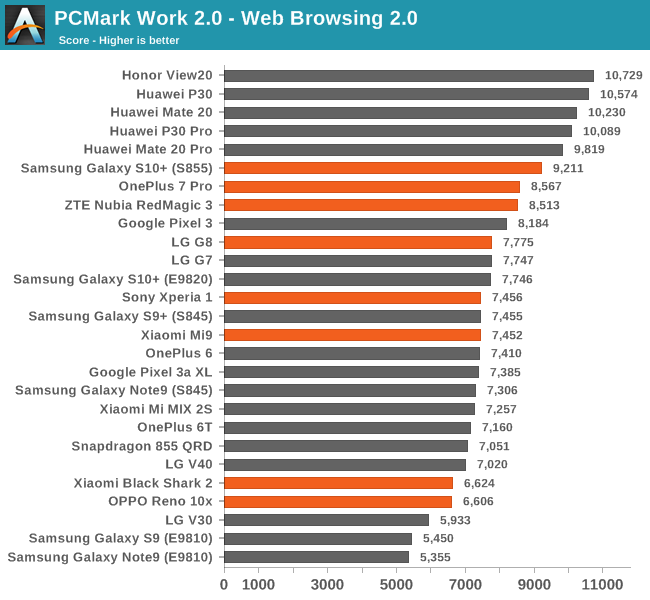
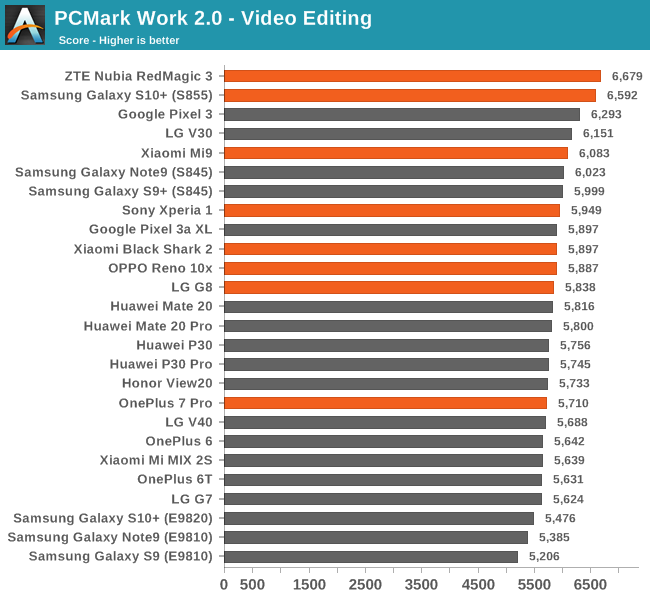
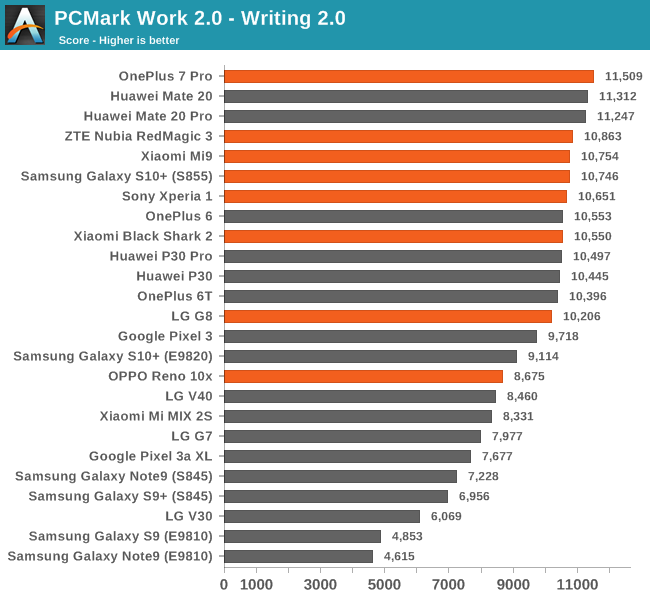
The writing sub-test is amongst the most important ones in PCMark as it’s the most representative of real-world performance experience of a phone. Here, all the Snapdragon 855 phones perform very well, except for the OPPO Reno.
I have to mention that the phone I’ve reviewed came with the Chinese firmware variant. The OS offered a “Performance” mode, however this mode was quite dishonest as it simply pegged the CPU frequencies to their maximum, instead of serving as a more responsive DVFS mode as found on the performance modes of phones such as from Samsung or Huawei.
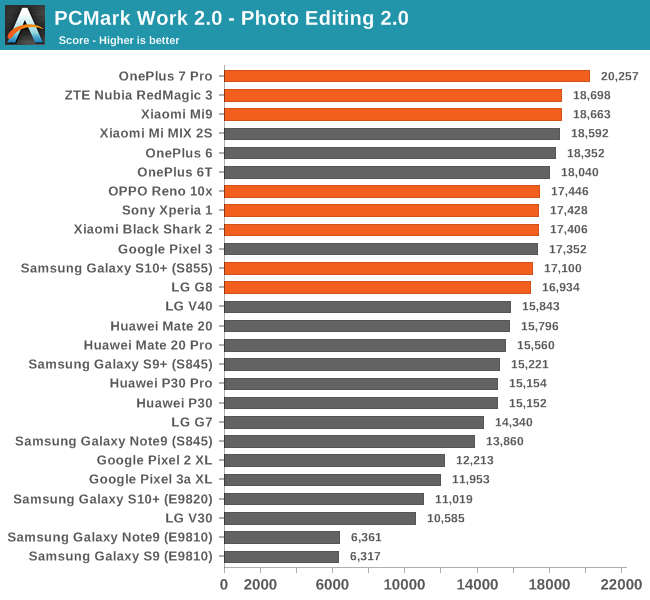
The OnePlus 7 Pro lead the pack here in the Photo Editing test which makes use of RenderScript Android API image processing functions, likely due to it’s 90Hz screen which does improve the measured responsiveness of the benchmark.
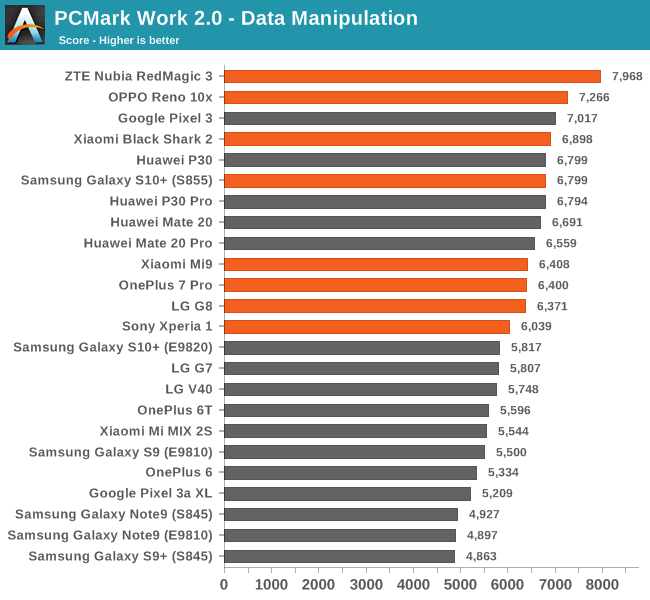
Interestingly, the RedMagic 3 leads the pack here when it comes to the data manipulation test which is characterised my a mixed thread workloads with a larger single heavy thread, pointing out to better scheduling on the part of the ZTE device and its software.
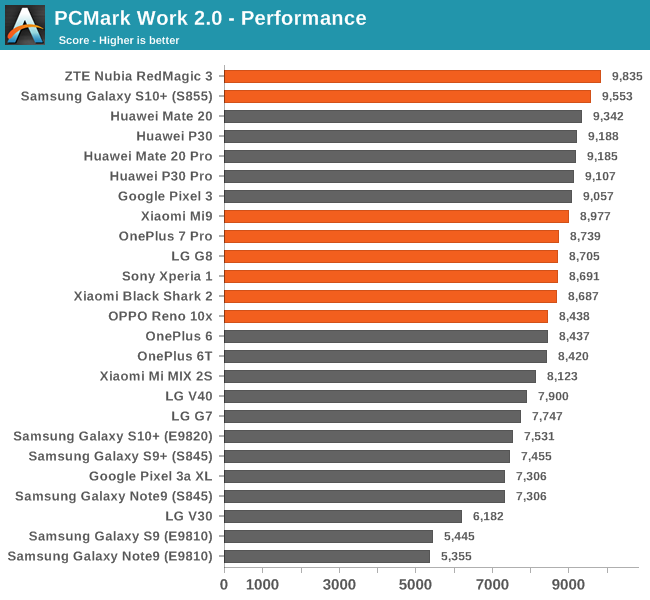
Finally, in the overall score, the ZTE RedMagic 3 comes at the top alongside the Galaxy S10. It seems that these two devices have the newest and most performance scheduler versions made available by Qualcomm, and why they end up at the top of the pack.
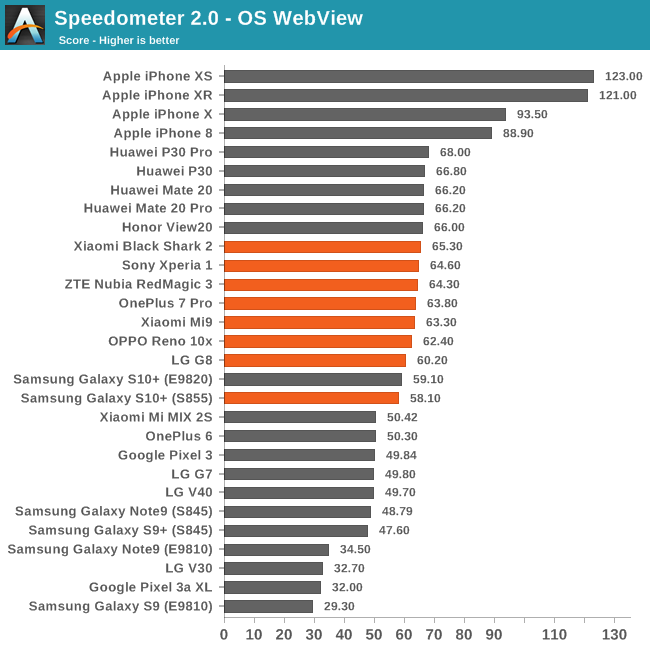
In the JavaScript web browser benchmarks, we again see a bit of a spread spectrum when it comes to the resulting scores. In Speedometer 2.0 the Galaxy S10 oddly remains as the worst performing device whereas other phones are more closely following the top performance of the Kirin 980.
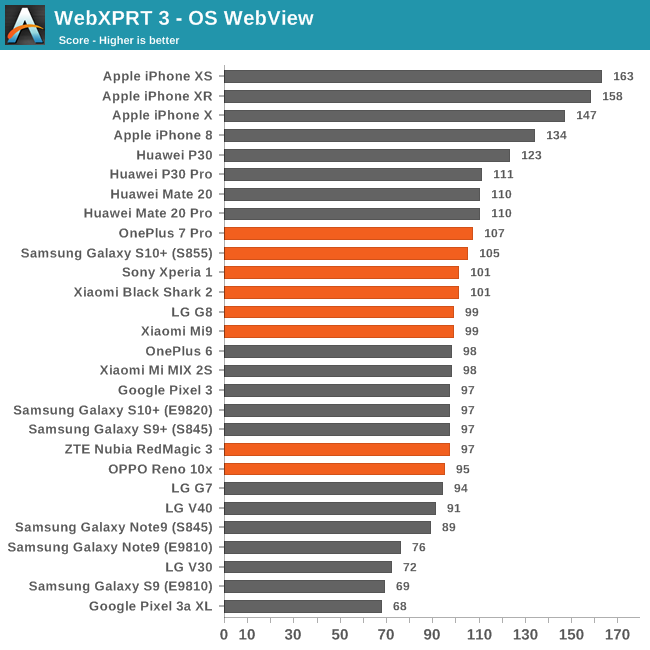
In WebXPRT 3, the S10 and OP7Pro take the top spots, although again slightly behind the Kirin 980 chipset devices from Huawei.
Overall, performance of all the Snapdragon 855 were quite excellent and all phones are among the fastest devices on the market, which should come as no surprise to anyone.
Machine Learning Inference Performance
AIMark 3
AIMark makes use of various vendor SDKs to implement the benchmarks. This means that the end-results really aren’t a proper apples-to-apples comparison, however it represents an approach that actually will be used by some vendors in their in-house applications or even some rare third-party app.
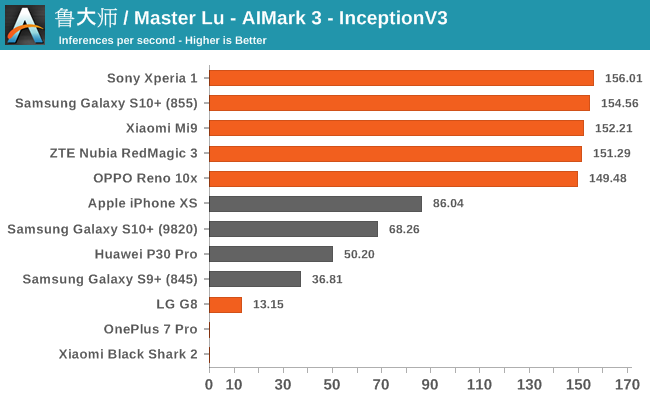
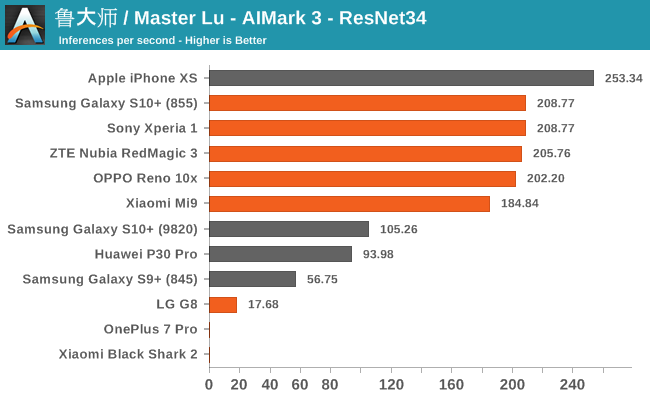
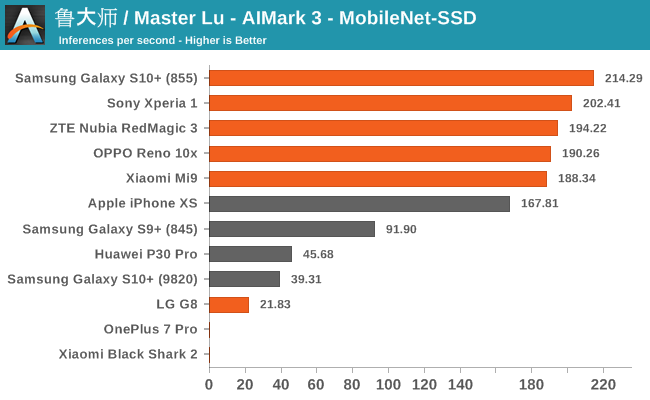
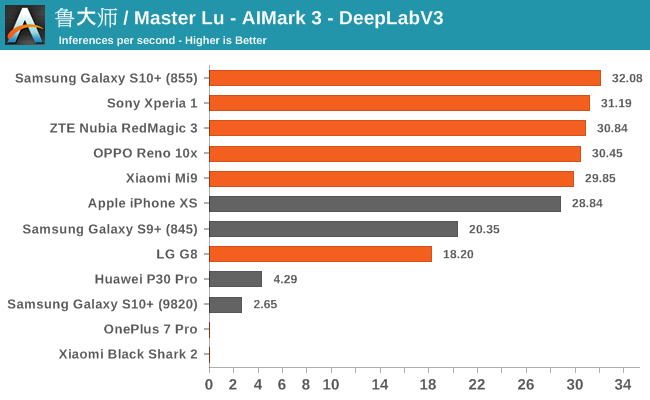
Summarizing the four sub-tests of AIMark 3, we see a few clear outliers: OnePlus 7 Pro and Xiaomi’s Black Shark 2 lack Qualcomms driver libraries on which the benchmark relies on (or they’re broken), and the application crashes. Another outlier is the G8, here the phone also lacked the libraries for hardware acceleration, but the app at least fell back onto CPU execution of the workloads, albeit at a massive performance penalty.
We notably see that AIMark has been able to implement Samsung’s NPU SDK as we’re seeing evident hardware acceleration. Huawei’s P30 Pro also makes use of its NPU here via its proprietary SDK. Naturally, Apple’s iPhone XS uses the CoreML framework to accelerate the AI workloads.
Overall, the Snapdragon 855 devices with the latest SDKs and frameworks here seem to compete extremely well, offering extensive performance that is leading the pack across all the different sub-tests.
AIBenchmark 3
AIBenchmark takes a different approach to benchmarking. Here the test uses the hardware agnostic NNAPI in order to accelerate inferencing, meaning it doesn’t use any proprietary aspects of a given hardware except for the drivers that actually enable the abstraction between software and hardware. This approach is more apples-to-apples, but also means that we can’t do cross-platform comparisons, like testing iPhones.
We’re publishing one-shot inference times. The difference here to sustained performance inference times is that these figures have more timing overhead on the part of the software stack from initialising the test to actually executing the computation.
AIBenchmark 3 - NNAPI CPU
We’re segregating the AIBenchmark scores by execution block, starting off with the regular CPU workloads that simply use TensorFlow libraries and do not attempt to run on specialized hardware blocks.
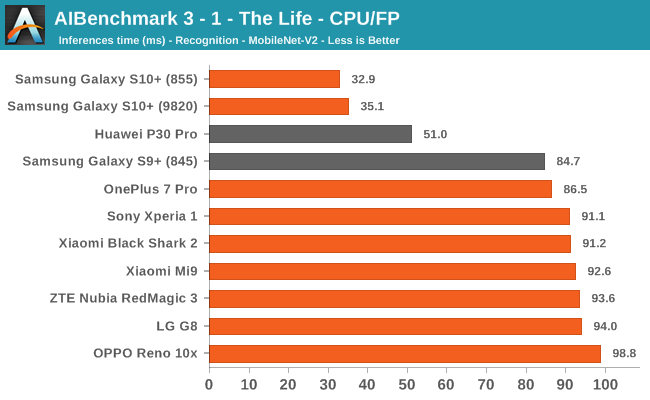
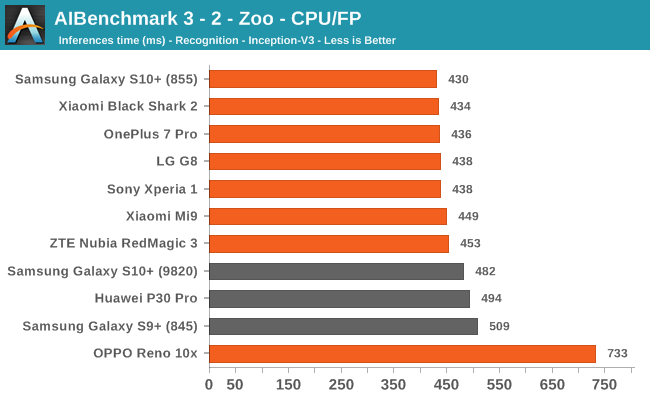
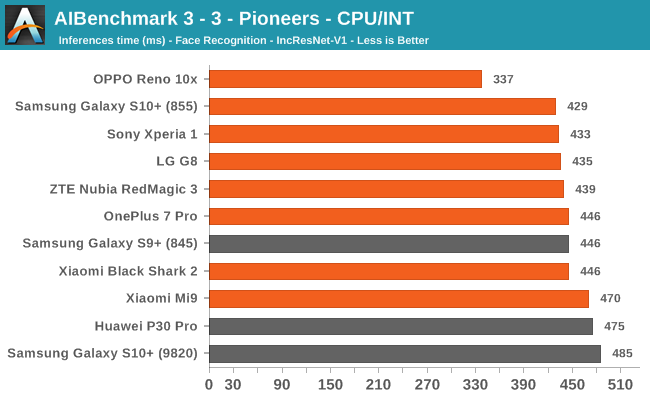
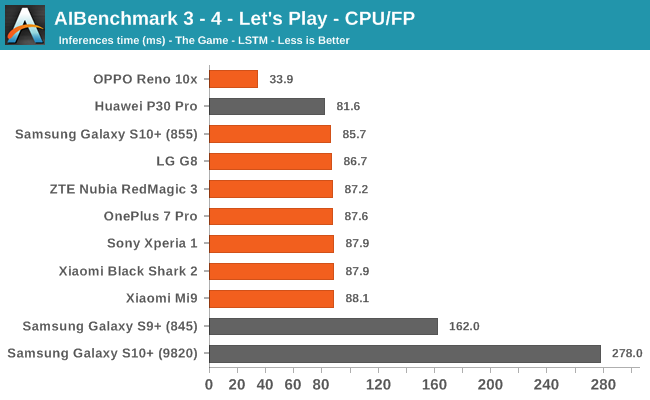
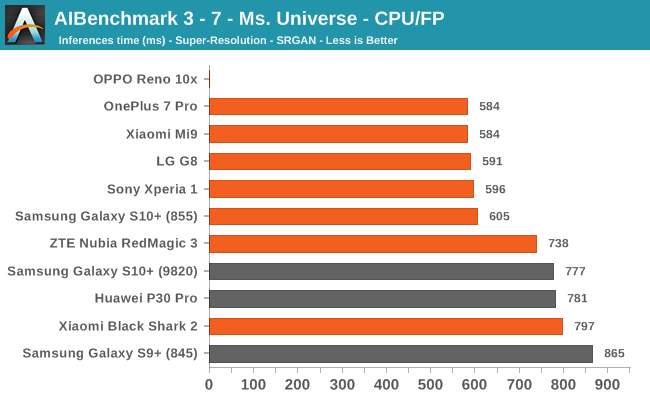
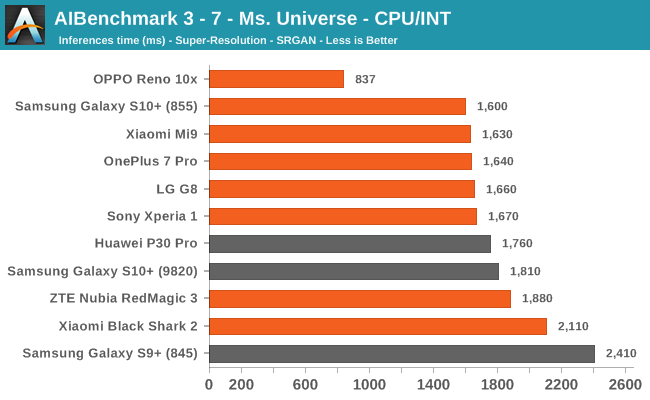
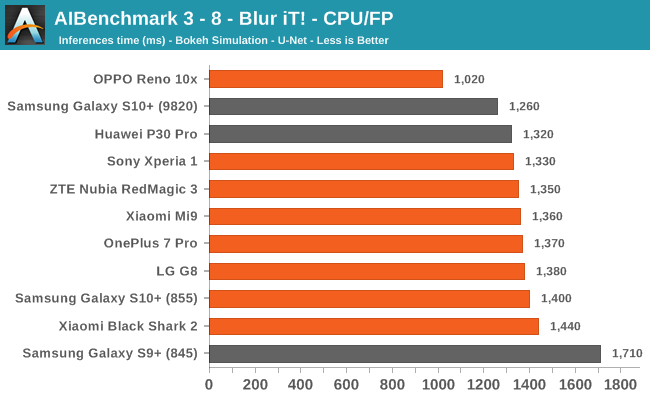
We’re seeing largely regular results here, although some observations pop up again, such as seeing that the Black Shark 2 having a very conservative result in some subtests. The other big outlier is the OPPO Reno 10x, here we’re seeing that the phone consistently performs better than the rest of the pack. This is very interesting, particularly because the phone actually isn’t able to actually use the NNAPI acceleration in the subsequent tests we’re covering next. This means that the “plain” TensorFlow libraries the OPPO is making use of are performing better than what’s employed for the rest of the devices.
AIBenchmark 3 - NNAPI INT8
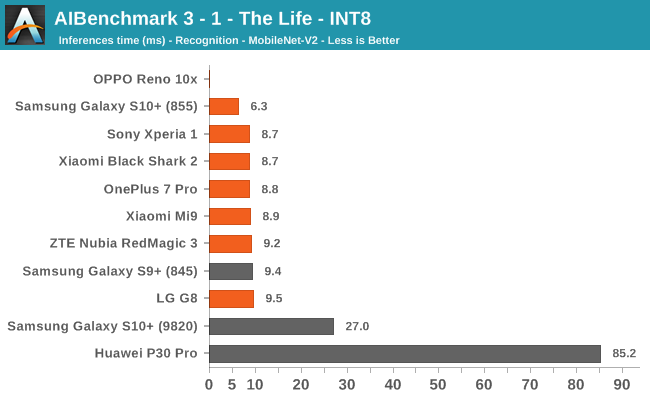
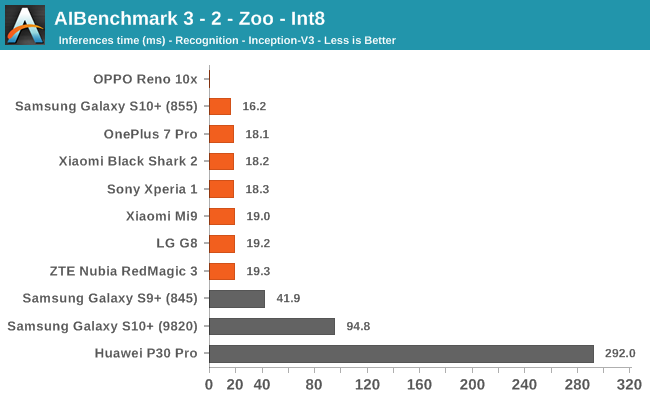
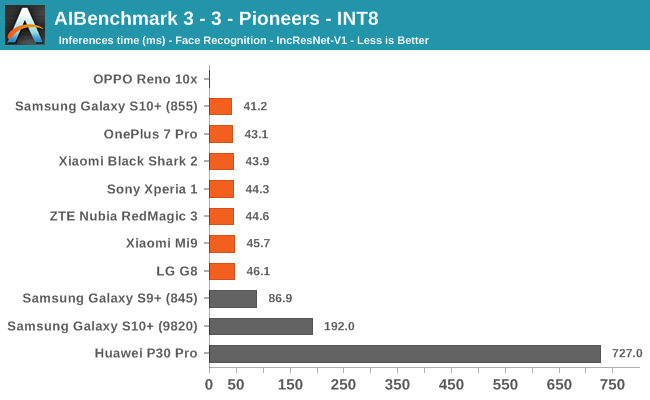
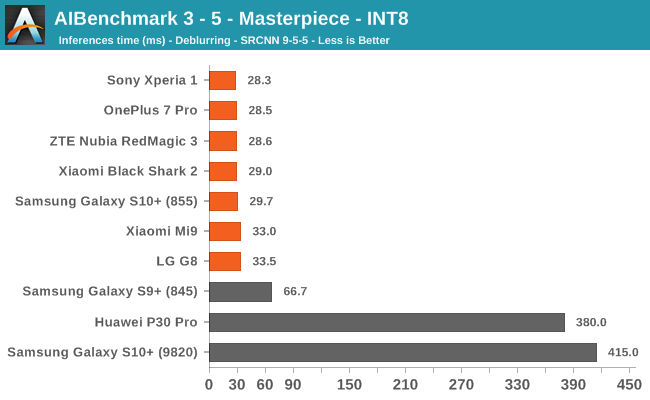
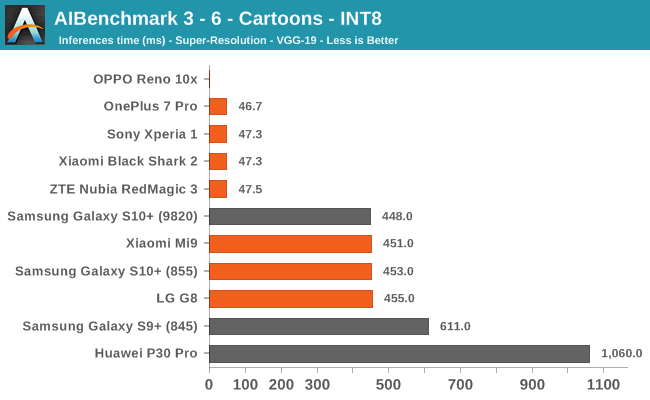
INT8 performance is dominated by the Snapdragon 855 devices, and this is thanks to the vector processing units of the Hexagon DSP. Test 3-6 stands out for some devices, and it’s likely that this is due to discrepancies in the NNAPI drivers which don’t fully accelerate things on the hardware for the S10, Mi9 and G8.
AIBenchmark 3 - NNAPI FP16
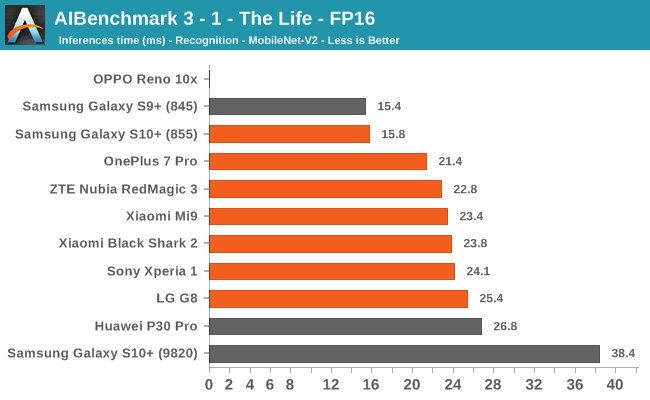
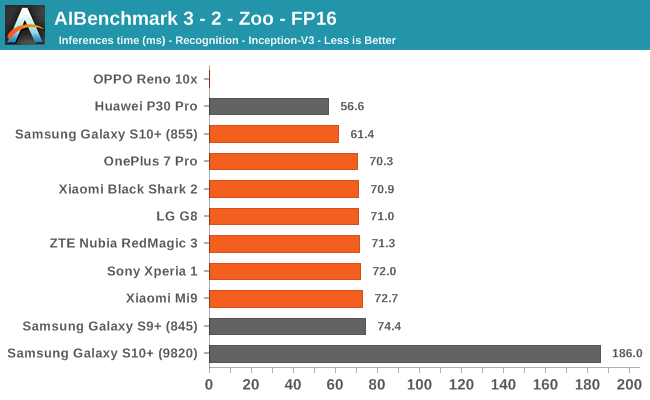
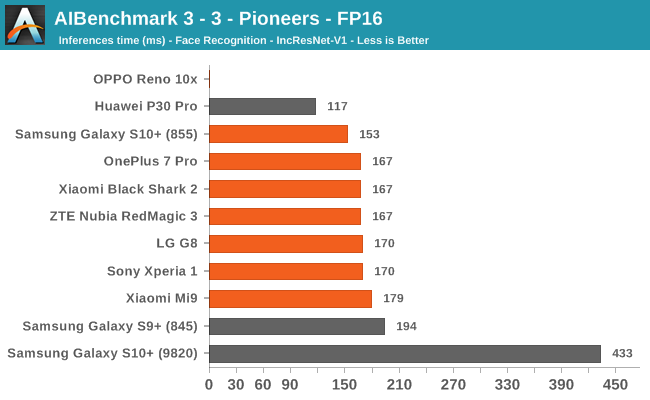
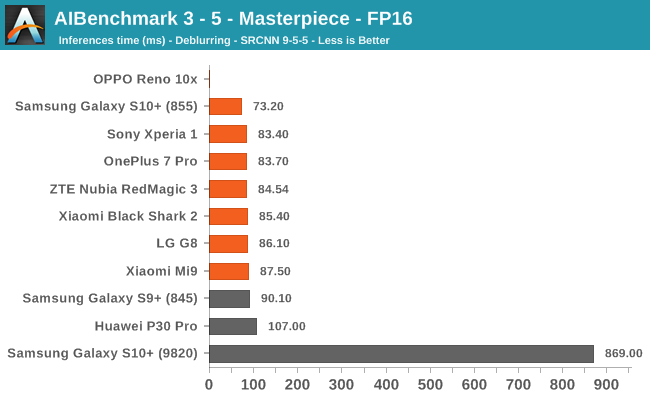
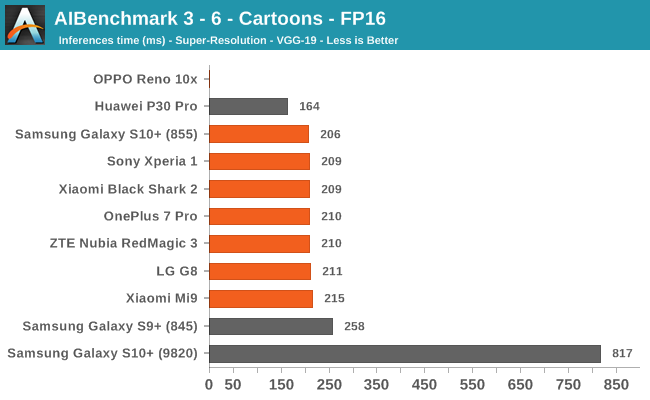
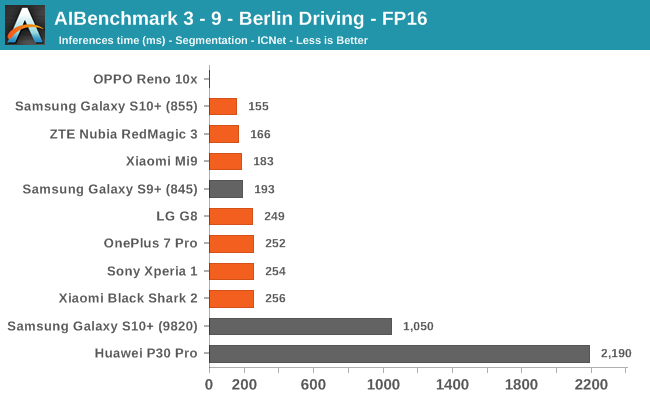
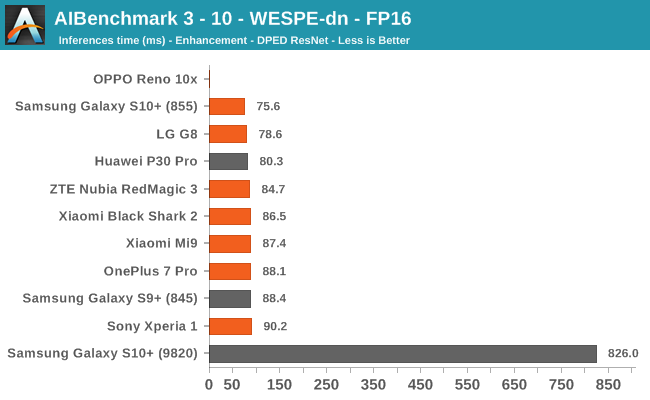
FP16 performance is again quite even across the board, with the difference coming down to DVFS and scheduler responsiveness. Here the Snapdragon 855 competes neck-in-neck with the Kirin 980, winning some tests while losing others. It’s to be remembered that the Kirin 980’s NPU doesn’t support INT8 acceleration at this time, and that’s why it shows up better in the FP16 benchmarks.
AIBenchmark 3 - NNAPI FP32
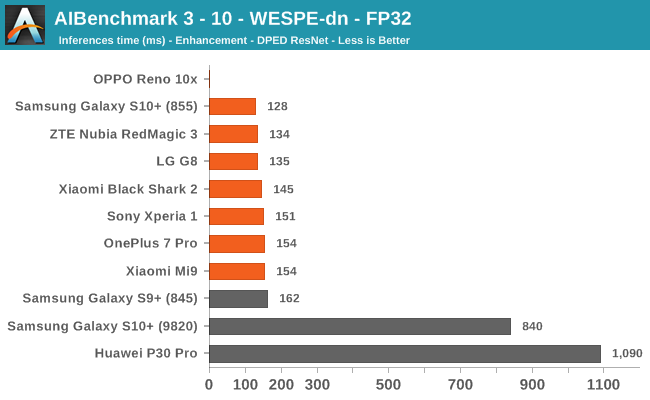
Finally, on the FP32 benchmark, Qualcomm accelerates these workloads on the GPU and is far ahead of the competition, which either have lacking GPU drivers or have to fall back to CPU acceleration.
GPU Performance
Gaming performance in a smartphone is dictated by three aspects: Firstly, naturally the hardware itself and how efficient and performance the GPU and Soc are. Secondly, the hardware design of the phone and how well it was designed to dissipate heat from the SoC to the whole chassis of the device, and secondly, the software thermal throttling configurations and how the vendor has programmed the thermal behaviour of the phone, such as how hot it allows the phone to get.
The results here can be all over the place depending on the vendor implementation, and it’s amongst the more interesting tests for this article.
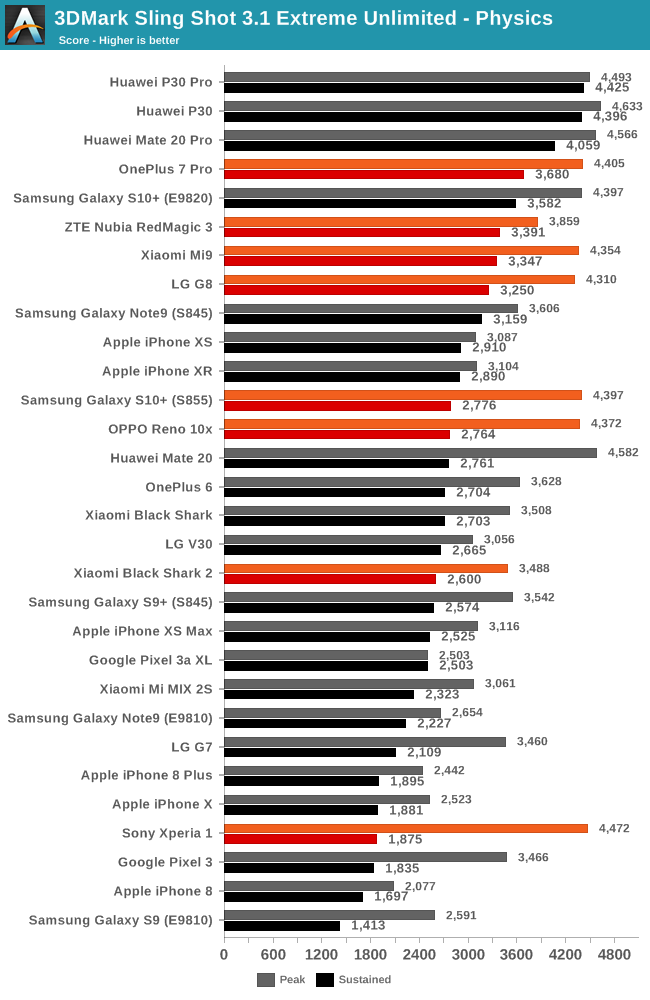
In the 3DMark Physics tests, we’re seeing largely a CPU load whilst the device is thermally constrained by it being heated up by the GPU load. The results we’re seeing here are very spread across the different vendors.
One result that does stand out is the Sony Xperia 1 which has some very bad throttling behaviour on the CPU, reaching only 40% of the peak performance of when the device is cold. The Black Shark 2 is also interesting as it showcases uniquely limited peak performance compared to the other Snapdragon 855 devices, possibly pointing out that Xiaomi is implementing a hard top CPU frequency cap when under GPU load.
The rest of the device vary in their sustained performance results. The best S855 device is the OnePlus 7 Pro, which is only showcasing a 15% degradation.
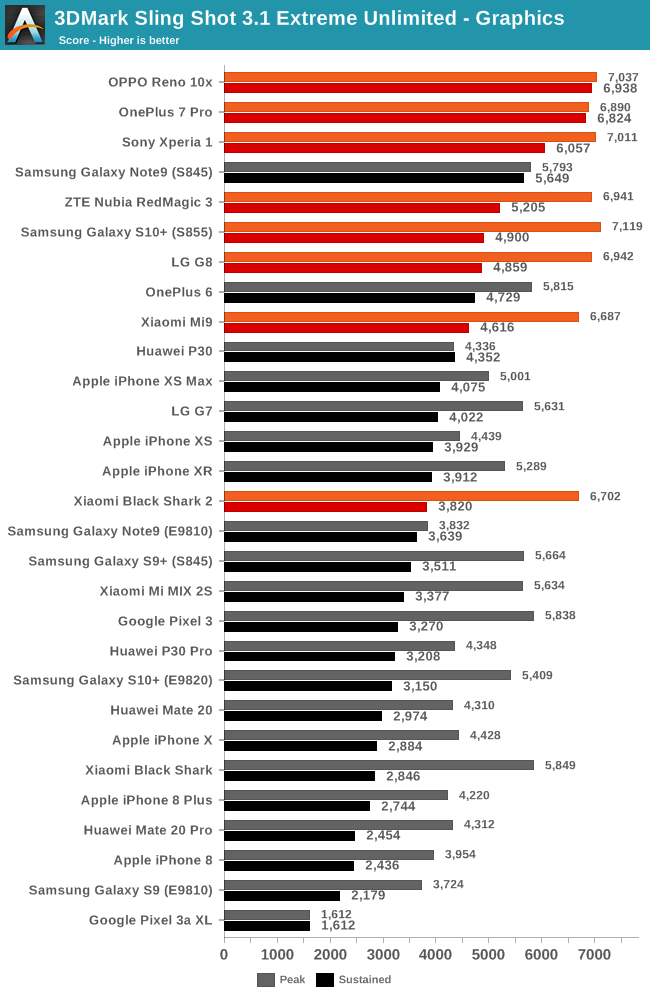
The two top devices are the OPPO Reno 10x, as well as the OnePlus 7 Pro which showcase nearly no throttling at all.
The Xiaomi Black Shark 2 showcases some pretty disappointing results, losing almost 45% of its performance when hot.
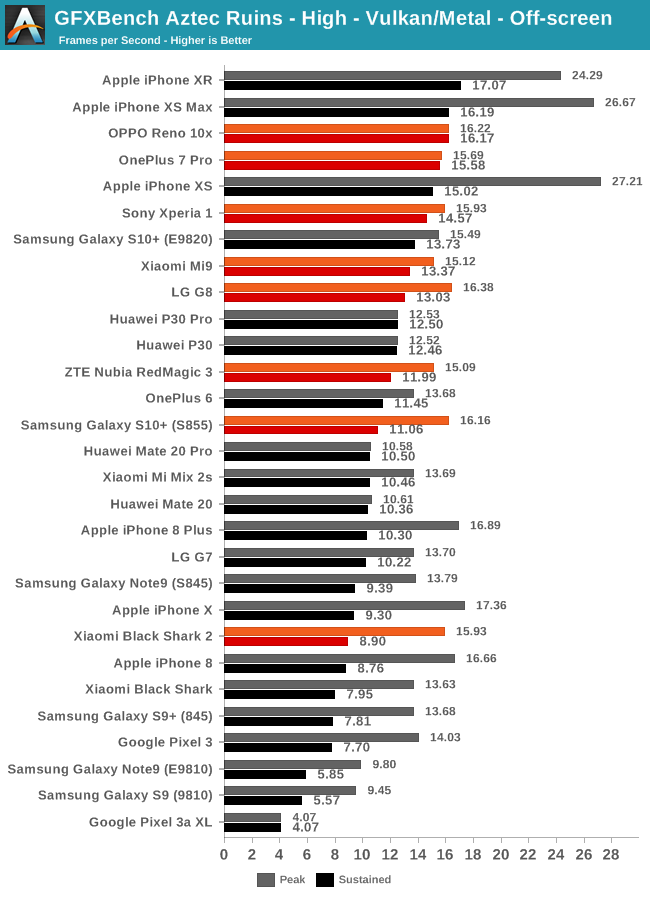
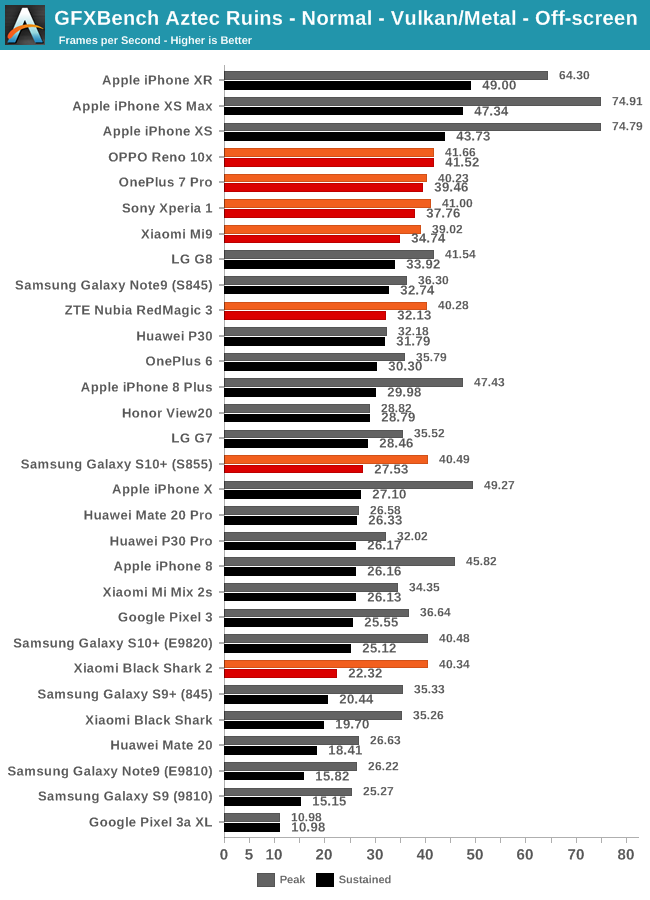
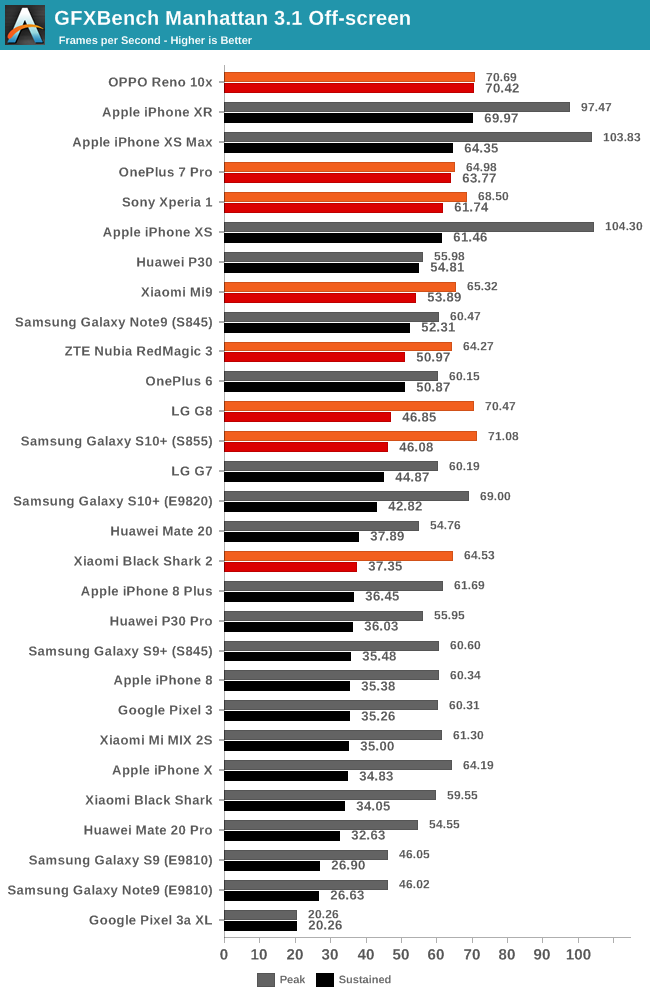
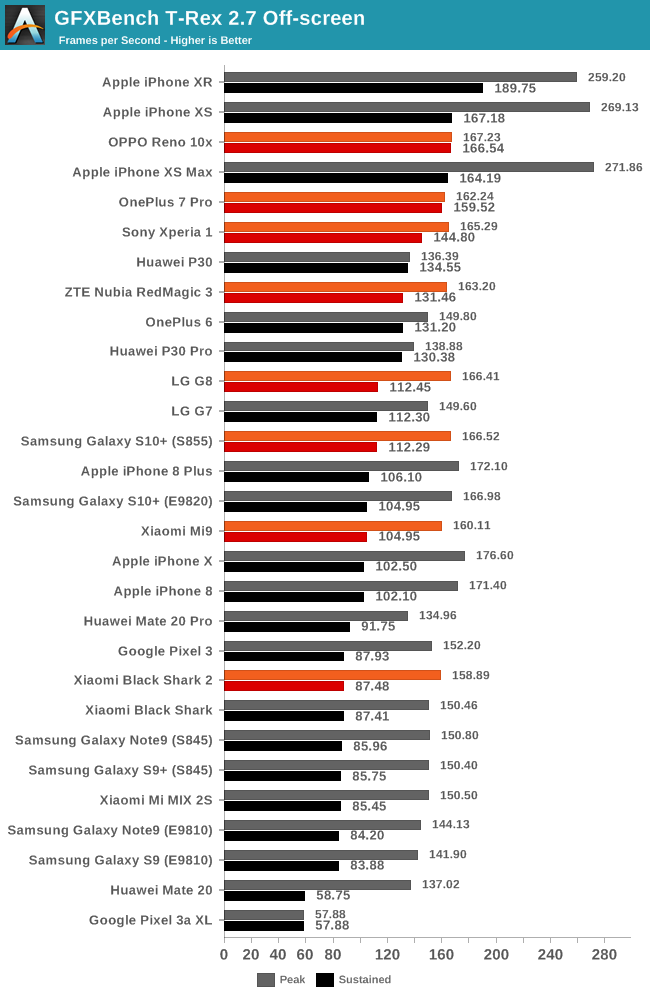
The 3D results continue on over the course of the GFXBench results. The OPPO Reno 10x and OP7Pro are the clear winners here in terms of sustained performance. The Xperia 1 and Mi9 also fare well, although the latter loses its edge in T-Rex which might be a throttling result of a different component such as the DRAM.
The issue with the OPPO Reno 10x and OP7Pro is that both devices get extremely hot. I’ve measured peak skin temperatures on the screen in excess of 50°C. In fact, the OPPO device actually stopped my benchmarking run via device overheating warning which is not something that you want to see in any phone; the hardware should throttle before such a warning is to occur. I’m not sure if this is a driver problem or something that both related vendors choose to deliberately implement, at least it doesn’t seem to be a cheating behaviour as I’m using modified benchmark ID APKs for our regular testing.
I mentioned in the device overview that the ZTE Nubia RedMagic 3 differs from all other phones, virtue of the fact that it’s using an actual fan in its internal design along with actual air intake and exhausts. Unfortunately, I wasn’t able to measure any kind of measurable performance or temperature differences with the fan either on or off. The little unit moves just so little air that it hardly makes any difference. Similarly disappointing was the Black Shark 2, which distinguished itself by offering the worst gaming performance of the lot even though it’s supposed to be a gaming phone, essentially eliminating itself from contention as a viable smartphone option for any kind of buyer.
The rest of the phones see a 20 to 40% degradation in performance from peak. The best device for gaming amongst the Snapdragon 855 crowd was the OnePlus 7 Pro, as it was able to achieve the highest performance figures all without running into issues such as overheating warnings.
Battery Life
While not strictly related to the performance or the Snapdragon 855 chipset itself, it’s also interesting to see how the different devices end up in terms of their battery life. In this approach we can identify how efficient the non-SoC components of a device are.
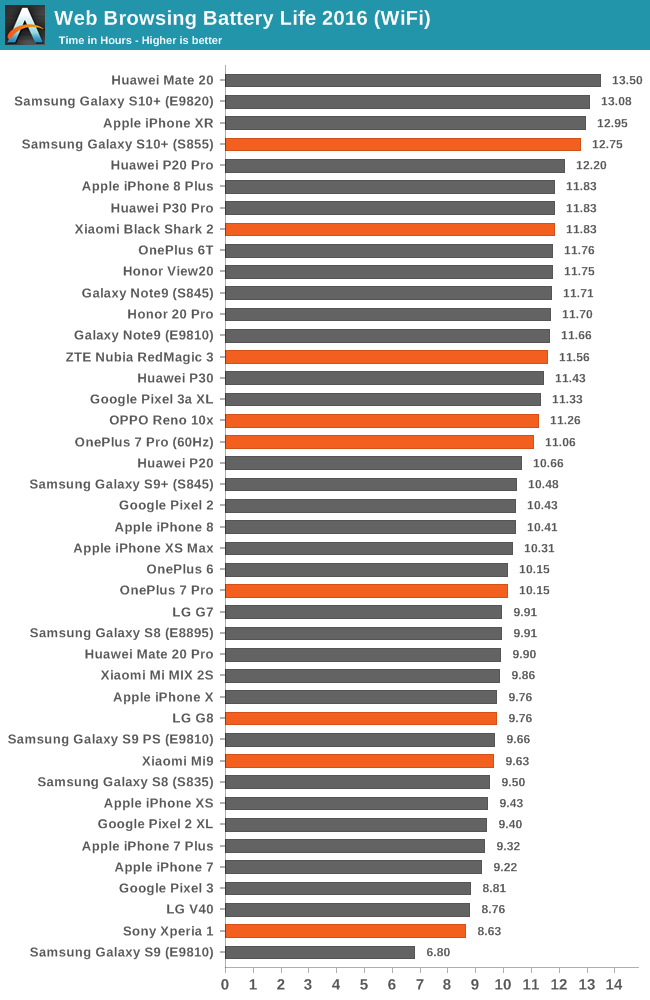
The Galaxy S10+ continues to dominate here, most likely due to Samsung’s newer generation OLED panel that seemingly might be employing a newer and more efficient emitter generation compared to all other phones in the comparison. Another aspect of the Galaxy S10 that is different to the other devices in the comparison is that it’s using Broadcomm’s BCM4375 WiFi 6 (802.11ax) chipset rather than Qualcomm’s own WiFi 5 chipset for most of the rest of the devices.
Sony’s Xperia 1 suffers from its 4K panel screen and the fact the DDIC has to work a lot harder to drive it, whilst devices like the G8 and Mi9 suffer from either an inefficient screen or simply a smaller battery capacity. The OnePlus 7 Pro in 90Hz mode has to make a battery compromise, while the remaining the devices are doing quite well, but just aren’t as power optimised as the S10+.
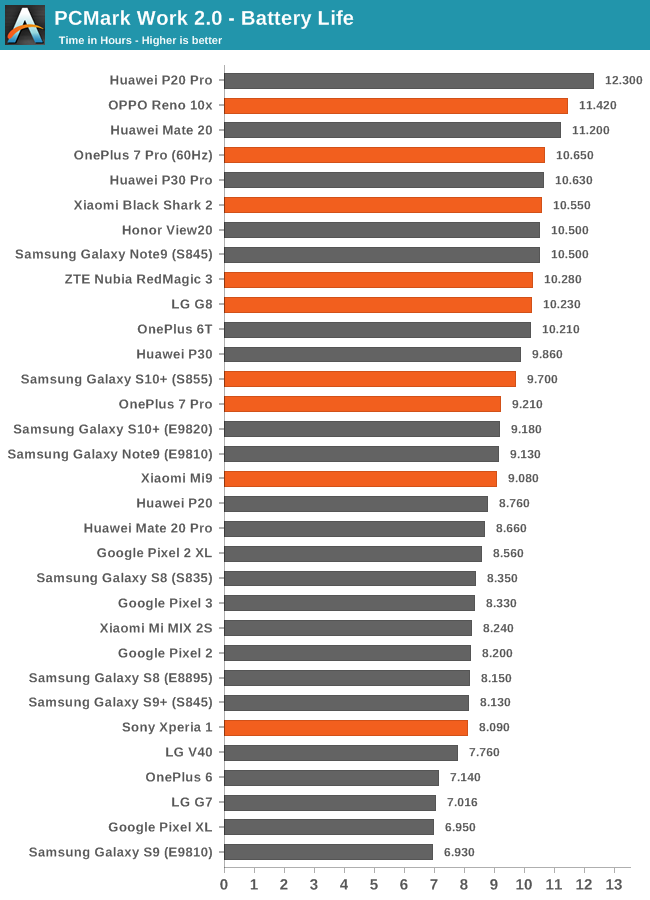
PCMark shifts the results around a bit. In this case, the same factors as on the web test play a role, however the SoC power efficiency has a bigger impact here as the CPU is a lot more active. Devices as the OPPO Reno 10x take the lead because they’re also showcasing the worst performance in PCMark due to the more relaxed scheduler and DVFS setting.
Overall still, all Snapdragon 855 devices except for the Xperia 1 are doing well in this test.
Closing Thoughts
Pitting 8 devices built around same SoC against each other ended up being an interesting exercise for us. In many ways it served as validation of some of the observations we made earlier in the year with the review of the first Snapdragon 855 devices, while also showcasing some rather surprising behaviors, particularly the gaming performance of the pair of gaming-oriented devices we tested today.
CPU Performance Remains A Software Matter
Back in January when we had the pleasure to test Qualcomm’s Snapdragon 855 reference device, we observed that that some benchmarks behaved a little odd and didn’t quite showcase the larger performance boost over the Snapdragon 845 that we had initially expected. These concerns were largely alleviated once we got our hands on the commercial Galaxy S10 with the S855, which showcased notably improved CPU performance thanks to a more reactive scheduler and DVFS configuration.
Over the months, I continued to see difference between the Snapdragon 855 phones, with some phones behaving well, while others showcased some rather conservative performance. Having 8 different phones at hand now I can pretty much say that some vendors delivered their S855 devices with more matured and fine-tuned software stacks than others.
Samsung’s Galaxy S10 remains the phone with the most responsive and fastest software tuning, having the fastest CPU ramp up amongst our tested devices. The OnePlus 7 Pro as well as the ZTE RedMagic 3 closely followed as the snappiest devices.
In terms of AI performance, we have come to the conclusion it’s also mostly a matter of software, this time in drivers. We saw some phones today that lacked the most up-to-date or best performance drivers, so even though again it’s the same chipset for all the phones, we've observed that performance can be different depending on the workloads. Some S855 phones even lacked the proper drivers altogether, and thus we couldn’t even complete the full machine learning inferencing test suite.
What is clear, however, is that none of the devices today were in any way bad performers. All the phones were able to offer excellent device experiences, and Qualcomm still largely maintains its leadership in this performance aspect, only really facing competition within the Android space from Huawei’s Kirin chipsets.
GPU Performance Is About Heat - How To Dissipate it And How Hot It Gets
Meanwhile, when it comes to the GPU performance, the performance of the phones ended up ranging rather widely.
At the very top of the charts we found the OnePlus 7 Pro alongside the OPPO Reno 10x. Both devices don’t exhibit any notable thermal throttling at all on the GPU, and thus are able to squeeze out the most out of the Adreno 640 in the Snapdragon 855. These high levels of performance however don’t come for free; both devices get exceedingly hot, with peak skin temperatures reaching over 50°C. The OPPO even interrupted our testing session with a device overheating warning – something we’ve seen quite a few times on Snapdragon phones over the last 2 years.
The rest of the devices ended up at various points on the performance curve, being heavily influenced by their physical thermal dissipation ability as well as their software thermal throttling configuration. In general, depending on environmental conditions, one can expect anywhere from a 20% to 40% degradation in performance over longer (30+ minutes) playtime sessions – that is to say if the game you’re playing is fully stressing the Adreno 640 GPU.
The most surprising results overall came from the GPU performance of the Xiaomi Black Shark 2 – and unfortunately things didn’t quite end up where we expected them to for the gaming phone. While the phone is advertised as being gaming-focused, it posted the worst sustained performance characteristics of all the Snapdragon 855 phones, barely showcasing much improvement even over last year’s original Black Shark.
We’ve also seen that different phones have different thermal limitations for the CPU and GPU. For example, Sony’s Xperia 1 clearly has a very aggressive CPU throttling mechanism; however it gives the GPU quite a lot of thermal headroom, ending up performing quite well in our set of benchmarks. Samsung’s S10 ended up in the lower half of the pack, performing below average.
Overall the clear winner in terms of representing the best Snapdragon 855 gaming performance goes to the OnePlus 7 Pro, as its hardware design is the best in terms of distributing the SoC heat throughout the whole body of the phone, and thus being able to maintain the highest performance even at a cost of higher skin temperatures.
Today’s test results reinforce a notion that I’ve been trying to spread over the last couple of years, and that is the better your power efficiency is, the better your performance will be. Over the last few generations Qualcomm’s rate of improvement seems to have slowed down, and our data shows that Apple’s SoCs now power the best-performing devices. Among the Android vendors however, Qualcomm has maintained a measurable lead both in terms of performance as well as the user-experience. Qualcomm’s strength here is the software, and although we’ve seen some differences today with the various Snapdragon 855 implementations, hopefully we’ll see more harmony in then next generation of chipsets.

